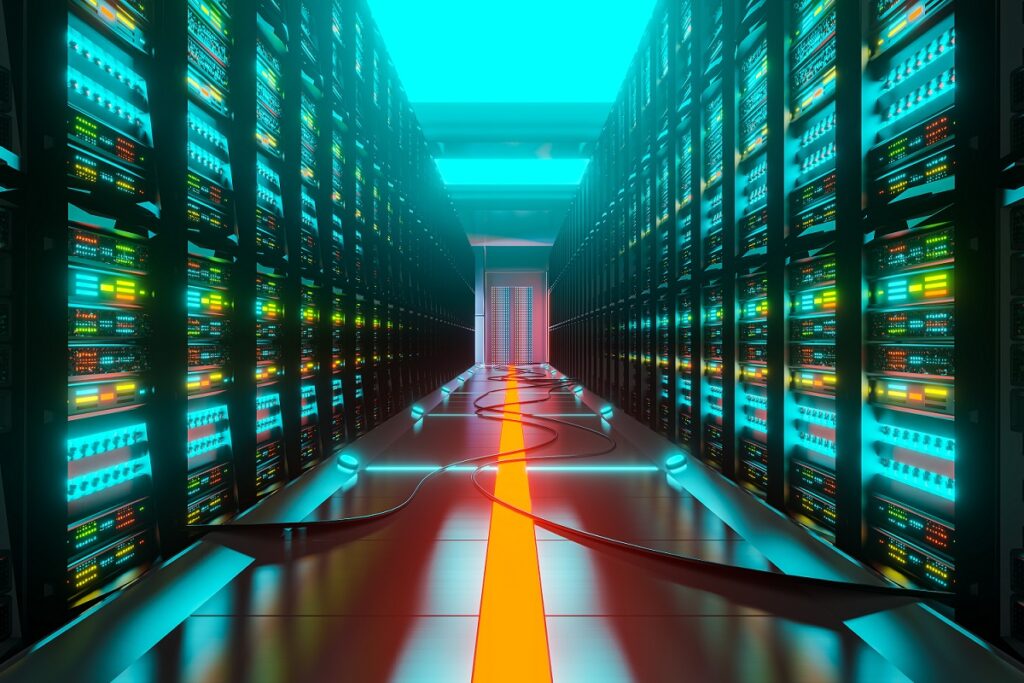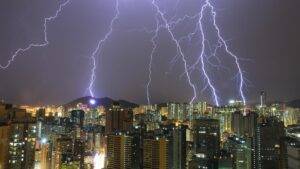Where do Netflix & Amazon Prime store the thousands of Movies & TV Shows they stream on their websites and apps? They don’t keep all these terabytes of data on your computer or your phone. They keep them in Data Centres – massive buildings with thousands of racks of servers that hold mission-critical information for thousands of businesses across the world.
Need for Earthing and Lightning Protection in Data Centers
The last few decades of computing have seen a massive increase in data creation with businesses becoming completely dependent on this new data to run their business. With this dramatic increase in electronic data production, businesses store their data in Data Centres. As a result, we have seen a concurrent steep growth of Data Centres around the world. These Data Centres are built with hundreds or thousands of servers and racks that are sensitive to heat and electrical fluctuations.
Data centres are run with a promise of:
1) High Uptime – Businesses should always have access to their data.
2) Speed – For quick uploads and downloads.
3) No Data Loss – Businesses should not lose any of the data they upload to the data centers.
Data loss is the prime selling point of a well-designed data center. The methods to ensure high levels of speed, uptime and data handling capacity are intertwined at Data Centers through:
A) Elaborate Power Supply system with redundant generators to ensure that servers are always powered.
B) AC and Cooling systems to keep the servers at the optimum temperature to avoid fires & faults in the servers.
C) Earthing, Bonding & Surge Protection systems to ensure optimum uptime and no data loss. Even a small surge in an unprotected data center could cause important services like Netflix (which runs on AWS) to become completely unavailable in a country.
International Standard References for Data Centre
- EN 50310 and ISO/IEC 30129 – Telecommunications Bonding Networks for Buildings and Other Structures.
- ANSI/TIA-607-B – Generic Telecommunications Bonding and Grounding (Earthing) for Customer Premises.
- EN 50600 and ISO/IEC 22237 – Information Technology – Data Centre Facilities and Infrastructures.
- IEC 62305 – Protection Against Lightning
It is important to use these standards during the design process for the earthing & bonding of any new or existing data centre. To design the best earthing network, the concept of Lightning Protection Zones (LPZ) should be used – you can learn more about LPZ’s here.
Why does Data Loss occur in Data Centers?
Data loss is the biggest concern in data centers and can happen due to intentional and unintentional reasons. Data loss in data centers can occur due to:
- Switching Surges
- Surges due to Indirect or Direct Lightning Strikes
- Power Outages and Fluctuations
- The potential difference between the different Earthing Components
- Network Failures
- Hardware and Software Malfunction
- Human Interference
- Cyber Attacks
Let’s look a little closer at two possible sources of data loss.
1) Data Cabling
Data cabling in data centers involves data routing, cable trays, and conduits with a large metal network to transport and connect all the cables. But these various cable networks and their connecting components, through the different floors and parts of the data center need to be at a common potential. As a result, equipotential bonding and earthing are important for maintaining the required potential.
Shielded twisted pair (STP) cables are used in data centers to prevent electromagnetic interference (EMI) in data transmission. But these cables require efficient earthing for effective functioning. The shield acts as a Faraday Cage preventing electromagnetic interference (EMI) from reaching the internal signal wire. But if the earthing is not effective there is a risk of the induced voltage in the shield which can produce interference in the internal signals. This can result in reduced efficiency, low data transfer speed and therefore data loss which cannot be accepted in data centers.
2) Earth Loops
Earth loops are another risk factor for Data Centres. Earth loops occur where two or more earthing connections are at slightly different voltages. Due to the very low impedance in the earthing cables, even small voltage differences are sufficient to create current loops in the equipment. This current is detectable as a ‘hum’ in audio equipment.
Potential differences can also be due to various other reasons like static electricity formed and transferred while people walk over the raised access floor. Signal Reference Grids (SRG) can be laid below the raised floors which can effectively reduce the potential difference between various points in data centres and avoid earth loops.
Protection Measures for Data Centers
Any kind of surges, odd harmonics, or potential differences create noise and thus affect the data quality, speed and efficiency in a data centre which cannot be afforded in modern data centers. Some of the major protection measures for overcoming these causes are explained below:
A) Signal Reference Grids (SRG) or Mesh Grids
The Signal Reference Grids are specially designed for data centres to provide an equipotential zone of reference. It consists of a network of low-impedance conductors installed throughout the facility to protect sensitive equipment from transient overvoltages. The SRG is constructed using flat braided copper cable, flat copper strips, or round multi-strand copper conductors. Flat braided copper cable offers superior performance, due to the “skin effect” characteristic of high-frequency signals in the data center facility. The pedestals are bonded to the signal reference grid by conductors through equipotential bonding bars. The data and the power cables are also to be laid close to the SRG.

There are 3 types of Mesh Networks that can be used:
1) Mesh Bonding Network (Mesh–BN) – generic bonding network with a fine maze of bonding conductors.
2) Mesh Isolated Bonding Network (Mesh-IBN) – only the single point of bonding of the mesh is connected with the protective bonding.
3) Star IBN – an IBN deployed into a star network instead of a Mesh Network.
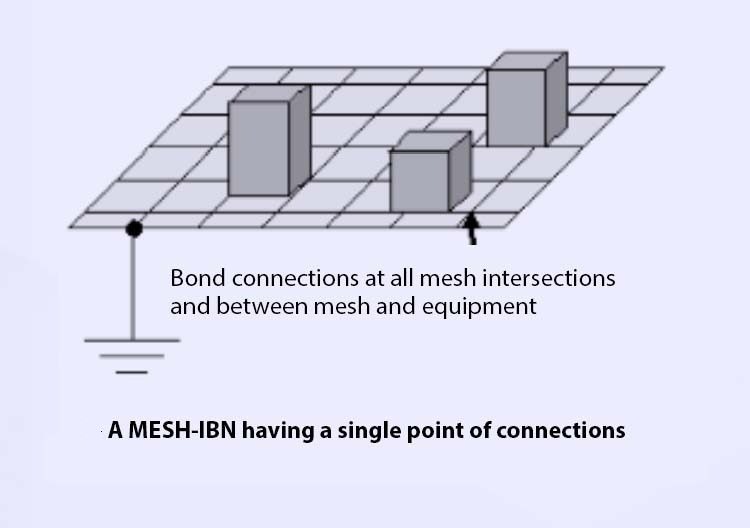
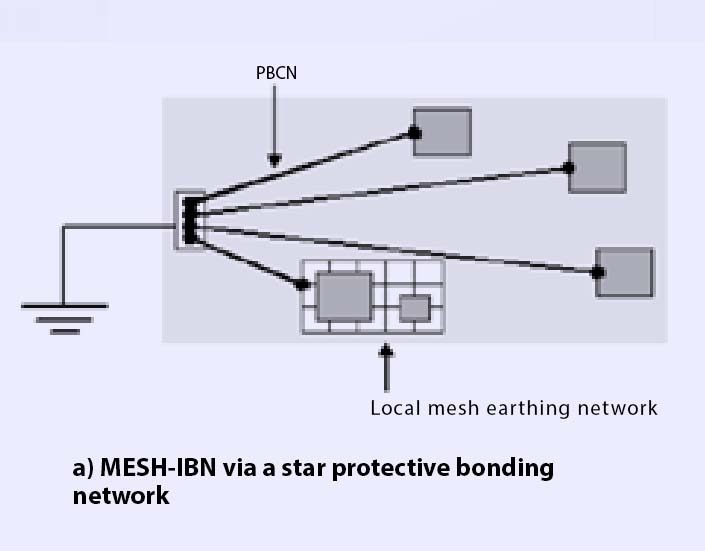
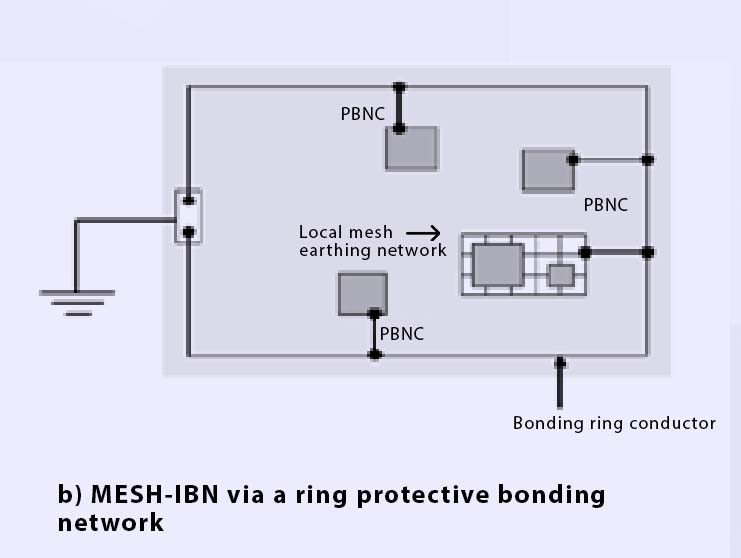
B) Room Shielding
The data center is packed with computers, servers, cabling, UPS systems etc. which increases the chance of developing Electromagnetic interference. The electromagnetic fields interact with each other and distort the data and result in data loss or disruption. Electromagnetic interference can be caused due to the electronic systems within the facility, induced by lightning with high voltage strikes, power supply systems and so on. Shielding is the best practice to reduce the events of data loss due to electromagnetic interference.
Shielding is the technique of surrounding electronics and cables with conductive or magnetic materials to protect them from incoming or outgoing EMI. Different types of shielding products such as metallic coatings, compounds, and metals such as aluminium, copper and steel in form of meshes, strips, and even metalized fabric are available to block electromagnetic interference. The data centre floors and the important areas and facilities need to be protected with the help of shielding.
C) Equipotentialisation
Equipotentialisation is the process of bringing all the surfaces to the same potential by bonding them using conductors. Effective bonding and grounding is very essential to ensure the effectiveness of the shielding. All the metallic components within the data center including the signal reference grids of each floors, the shielding systems, the raised floors, cabinets, cable conduits etc. are to be connected by equipotential bonding and connected to the common earthing.

D) Earthing for Data Centre Cabinets
Usually, data centers have conventional earthing systems for all their equipment as this can reduce the risk of earth loops. But it is recommended to earth the data center racks and cabinets separately. This can help to minimise the effects of power surges and damages related to it. The data center cabinets and racks can be connected using jumpering, nut bolt connections with paint piercing washers etc for making electrically continuous joints and earthing them. It is crucial that the earthing system design aligns with the design of the data centre from the start. Also, all the electrical earthing connections are accessible throughout the data center.
As per EN 50310 and ISO/IEC 30129, there are several ways to bond and earth your data centre cabinets which are shown in the figure below.
Earthing for Data Centre Power Supply Systems
It is estimated that 1% of global power usage is by data centres. This power supply to data centres is critical because power outages or voltage variations can lead to downtime and reduced efficiency for the data centre.
Data Centres consume large volumes of power (100’s of MW) for which they require multiple levels of protection. As a result, they usually have dedicated power supply systems which are uninterrupted power sources for reliable operation. Substations are also used to feed large data centres that have high power requirements. As a result, the power feeding system including the substation, HV transmission lines, the UPS systems also need separate earthing and lightning protection. The power cables for transporting the power supply need to be earthed and shielded for protection. The power cables and conduits that help in transporting power to every corner of the data center also require earthing.
Learn More about Earthing for Transmission Lines
Learn More about Earthing for Substations
Cooling Systems
Cooling systems play a crucial role in the effective performance of the data center. As the number of servers increases, temperatures inside the data centre also increase proportionally. At high temperatures beyond the tolerable limit of the servers and racks, these systems can cause power surges and even fires. This is why air conditioning and cooling systems are important in the performance of data centers.
The cooling system in data centers has a complex design that needs to be protected from all surges and instabilities to avoid outages. As a result, earthing and bonding is important for the protection of HVAC and cooling systems in data centers.
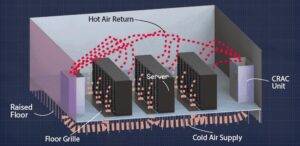
Earth Mats/Grids for Protection of the Complete Infrastructure
Conventional earthing design techniques based on International standards are to be followed for the earth mat design of data centers.
The data centre earthing can be easily understood at different levels starting from the first level including cabinets and racks being bonded, second level including the various equipment which includes the servers, power systems, HVAC control systems, other hardware etc. Then comes the signal reference grids or floor earthing, next is the containment earthing consisting of every component being connected to the equipotential bonding bars. The different floor grids are then connected together and finally connected to the foundational earthing which is the earth grid or earth mat. Thus the earth mats form the primary earthing for the complete structure.
Earth mats are important for the substations or the power supply systems including the UPS systems feeding the data centers and the HVAC and cooling systems of the data centers. The earthing design and implementation of earth mats and earth grids must follow the techniques specified in IEEE 80.
Testing the Earthing System of a Data Center
Soil Resistivity
Soil resistivity is always the primary factor considered while designing and testing the earthing system of any facility. Multiple soil resistivity tests are conducted using the Wenner method. The earthing electrode has a sphere of influence in the ground where it is placed, not just along the surface but in all directions. So, it is important to know the influence of the electrode in the discharge of electrons into the deeper layers of the soil. Thus, a soil resistivity model for this data centre site is formed from these initial tests. It is the base of the electrical earthing system design and is important to eliminate any error from Soil Resistivity Testing. The final Soil Resistivity of data centers should be less than 1ohm. Various techniques and methodologies are used to calculate the earth points and identify the resistivity values.
Learn More about Soil Resistivity Testing Techniques here.
Once this is identified the next step is to implement the protective measures and earth-enhancing techniques for maintaining this desired soil resistivity. The various techniques based on IEC 62305 and IEEE 1100 for electronic equipment etc are to adhere to the earthing requirements. The various methodologies can involve Type A, Type B earthing, soil treatments, or even complete soil replacement before construction.
Earthing is Critical for Data Centre Functioning
Due to the ever-increasing demand for cloud-based and remote hosting resources, there has been a significant increase in calls for more capacity on Data Centre providers worldwide. Thousands of commercial activities can come to a standstill if the computers in the data centers do not function as intended. Every minute of the data center downtime can have severe consequences and this is why it is expected to be completely secure. This is why the Earthing, Lightning Protection System, Surge Protection, and Equipotential Bonding for data centers is very crucial to ensure uninterrupted functioning.
If you are building a new data center, contact us to design an earthing system to ensure that your data center has the highest uptime, and speed with zero data loss.
Thank you for reading the blog, Axis is a leading manufacturer and supplier of Electrical Components to over 80+ Countries. Talk to our industry expert by visiting our contact us section. You can also watch our videos by our experts – click here.

